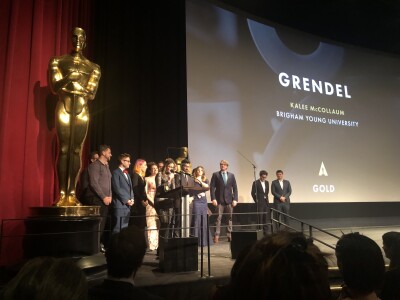He's an icon who has appeared in the Sunday paper for more than half a century, but there are still some sides of Charlie Brown the public has yet to see. For example: the back of his head.
This was the challenge facing a team of talented artists at Blue Sky Studios (owned by 20th Century Fox), which included BYU Illustration professor David Dibble and six other alumni from the BYU Department of Design. The group was tasked with transforming the two-dimensional world of Charles Schulz's characters into a three-dimensional feature-length film.
"In the 1950s, Charlie Brown comic strips were a little more 3D and had some depth and perspective in the drawings," Dibble said. "But in the 70s, 80s and 90s, not only did Schulz progressively flatten down the space, he stuck a flat brick wall in front of the characters in many scenes to eliminate depth. We never see the back of Charlie Brown's head, we don't see him from a three-quarter angle. He's always drawn from a profile view or straight on."
Dibble worked as a visual development artist on "The Peanuts Movie," set to release Friday. Visual development artists design the color, shape, style and any other visual element that make up a movie. Dibble specifically created a style guide for fellow designers and animators down the production pipeline detailing the nuances for drawing like Schulz, which included references for pen strokes and line width.
In order to keep the tiniest details in harmony with Schulz's original work, such as a poster hanging on the wall in Charlie Brown's bedroom, every illustration had to be documented with a comic strip reference to prove it was consistent with tradition.
"The level of research that went into this is something people won't necessarily see when watching the movie. To say we did a fairly deep dive to make sure that details are accurate to Schulz's vision is an understatement," Dibble said.
For example, because Schulz drew Charlie Brown slightly different in every strip, artists created a matrix of over 500 Charlie Browns before narrowing down the final design for the movie.
"We also don't want those details to be felt more than distracting. If people aren't noticing but it just feels right, then we've done our job right."
The influence of BYU graduates stretches from the beginning of the production process throughout the entire movie, with some spending more than two years on the project.
BYU Alum Jeff Call helped visualize the movie as a story artist, creating a blueprint of the movie for other departments to use.
"The script leaves a lot up to interpretation and we're the ones trying to tie it down," Call said. "Every audience member is going to bring certain expectations when they come to watch the movie. We needed to meet those expectations and hopefully surpass them."
Fellow BYU grad Tyler Carter, also a visual development artist, was responsible for designing the look of the Peanuts' world as well as Snoopy's imagination, an area not heavily explored in the comics.
"When I first started on the film over three years ago, I was quite intimidated," Carter said. "Peanuts is synonymous with American culture in such a way that it's almost sacred. Like the rest of the country, I grew up watching the Bill Melendez specials. For me, it's an honor to work on a film like this."
The fantasy world, which equates to approximately 6,000 miles of computer generated land, is where Snoopy faces off against his arch nemesis, the Red Baron. To create this world, Carter drew on his childhood memories of the towering Wasatch mountains for inspiration.
BYU graduate Seth Hippen was an animator on the film responsible for some scenes that included Charlie Brown, Woodstock, Snoopy and Linus. He said his biggest challenge as an animator was mimicking the rough movement of the original Schulz work in the smooth 3D format.
"The animation in the holiday television specials was shot on a budget, and movements can be a little snappy moving from a straight on view to a profile view," Hippen said. "We didn't want to lose that feel, so to make it work in 3D we would animate one or two frames indicating the head was turning a certain direction and then we would snap it into profile."
Other BYU alumni who contributed significantly to "The Peanuts Movie" include Raphael Tavarez (materials artist); Michael Murdock (lighting technical director); and Brandon May (lighting technical director).
The BYU Department of Design is accustomed to being in the national spotlight for work produced by the animation, illustration, and graphic design programs. A 2013 news feature in The New York Times touted "Out of nowhere, B.Y.U. --- a Mormon university owned and operated by the Church of Jesus Christ of Latter-day Saints --- has become a farm team for the country's top animation studios and effects companies."
Dibble agrees.
"In the way our programs are structured, the students are working in teams and that translates very well to a professional setting," Dibble said. "You need to be able to work with people. Those recently graduated students start out with a company and, because of their character and work ethic, very quickly become respected leaders."










